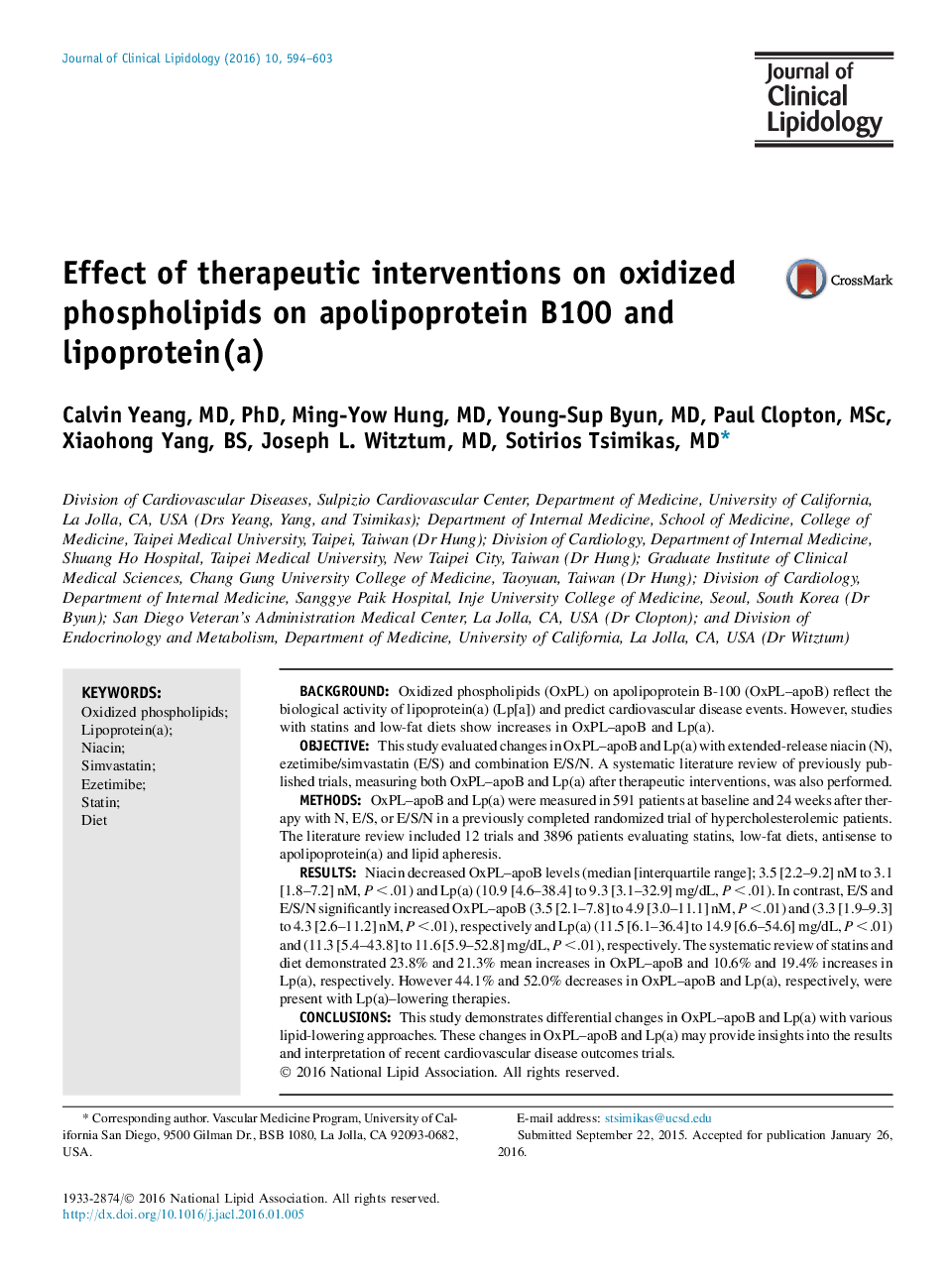| Article ID | Journal | Published Year | Pages | File Type |
|---|---|---|---|---|
| 5985317 | Journal of Clinical Lipidology | 2016 | 10 Pages |
â¢Niacin lowers OxPL-apoB in conjunction with Lp(a).â¢Ezetimibe/simvastatin increases both OxPL-apoB and Lp(a).â¢A systematic review of trials including OxPL-apoB and Lp(a) measurements showed:â¢Statin treatment increased OxPL-apoB and Lp(a) levels.â¢Lipoprotein apheresis and antisense oligonucleotide to apo(a) lower OxPL-apoB and Lp(a).
BackgroundOxidized phospholipids (OxPL) on apolipoprotein B-100 (OxPL-apoB) reflect the biological activity of lipoprotein(a) (Lp[a]) and predict cardiovascular disease events. However, studies with statins and low-fat diets show increases in OxPL-apoB and Lp(a).ObjectiveThis study evaluated changes in OxPL-apoB and Lp(a) with extended-release niacin (N), ezetimibe/simvastatin (E/S) and combination E/S/N. A systematic literature review of previously published trials, measuring both OxPL-apoB and Lp(a) after therapeutic interventions, was also performed.MethodsOxPL-apoB and Lp(a) were measured in 591 patients at baseline and 24Â weeks after therapy with N, E/S, or E/S/N in a previously completed randomized trial of hypercholesterolemic patients. The literature review included 12 trials and 3896 patients evaluating statins, low-fat diets, antisense to apolipoprotein(a) and lipid apheresis.ResultsNiacin decreased OxPL-apoB levels (median [interquartile range]; 3.5 [2.2-9.2] nM to 3.1 [1.8-7.2] nM, PÂ <Â .01) and Lp(a) (10.9 [4.6-38.4] to 9.3 [3.1-32.9] mg/dL, PÂ <Â .01). In contrast, E/S and E/S/N significantly increased OxPL-apoB (3.5 [2.1-7.8] to 4.9 [3.0-11.1] nM, PÂ <Â .01) and (3.3 [1.9-9.3] to 4.3 [2.6-11.2] nM, PÂ <Â .01), respectively and Lp(a) (11.5 [6.1-36.4] to 14.9 [6.6-54.6] mg/dL, PÂ <Â .01) and (11.3 [5.4-43.8] to 11.6 [5.9-52.8] mg/dL, PÂ <Â .01), respectively. The systematic review of statins and diet demonstrated 23.8% and 21.3% mean increases in OxPL-apoB and 10.6% and 19.4% increases in Lp(a), respectively. However 44.1% and 52.0% decreases in OxPL-apoB and Lp(a), respectively, were present with Lp(a)-lowering therapies.ConclusionsThis study demonstrates differential changes in OxPL-apoB and Lp(a) with various lipid-lowering approaches. These changes in OxPL-apoB and Lp(a) may provide insights into the results and interpretation of recent cardiovascular disease outcomes trials.
